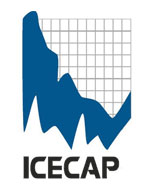By Anthony Watts, Watts Up With That
The irony, it burns. Do you think maybe Gaia is trying to send the U.N. and the delegates a message? One record low was funny, three in a row was hilarious, a new record low for the month of December was ROFL, but now six straight days of record lows during the U.N. COP16 Global Warming conference? That’s galactically inconvenient. The whole month so far has averaged below normal:

Enlarged here.
Here’s today from Weather Underground, Today’s low was 55F and the old record was 60F in 1999:
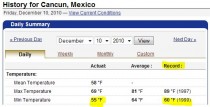
Enlarged here.
And here are the other 5 days.
The forecast for Cancun is not encouraging:

Enlarged here.
Existing record lows for the next two days are:
Dec 11 57 F (2003)
Dec 12 55 F (2008)
It is likely we will see a full week, possibly 8 days of record lows, and another new all time record low for the month of December is possible also.
By Art Horn, Meteorologist
Currently the annual Climate Catastrophe Party is marching along in Cancun, Mexico. Do they really need to do this every year? It does make for a nice all expenses paid vacation. At this latest doom fest some 20,000 delegates from around the world are doing their best to keep the scary story of man made global warming, pardon me, climate change alive. I’ve been around long enough to remember a time when global warming was a non issue. In fact it was the very real threat of another Ice Age that was making headlines in the 1970s. That’s right, it was the complete opposite of today’s predicted climate disaster. With that in mind I decide to do a little investigation into the comings and goings of predicted environmental cataclysm. What I found is that this has all happened before. The reporting of climate catastrophe has been going on for over 120 years. What’s fascinating about the reporting is that it has encompassed the full range of temperature, searing heat and bitter cold, both have been reported as real and potentially deadly. Before you shape your opinion on global warming by digesting today’s headlines you might want to consider the following.
The United Nations Intergovernmental Panel on Climate Change says the world is warming at an unprecedented rate. The irrefutable results of this global temperature heat wave will be starvation, drowning of coastal cities, mass extinctions, war and the death of billions. These warning come to us from many reliable sources including all forms of news media. We have been alerted to this climate catastrophe for two decades now. Surely all these respected and long lived newspapers, magazines and television networks can be trusted to tell us what the current state of the climate is and what it will do. At least you would think so. Interestingly the history of climate reporting reveals many dirty little inconvenient truths that are about to be exposed.
When one looks back at the history of climate stories in the media you find a remarkably consistent and reoccurring theme. All of this reporting of unrelenting warmth and the dire consequences that will result is really recycled news headlines from the past! The global temperature has cycled from cold to warm to cold to warm again over the last 120 years. The news media, fed by reports from universities and government climate experts has diligently reported how these climate changes could spell disaster for mankind. These media cycles of impending climatic doom mirror the climate cycles themselves but with a roughly ten to fifteen year lag. It seems whenever the world warms up the volume of global warming stories increases to match the trend. Conversely when the climate cools the major media outlets pull up on their long johns and warn us of the next ice age. However it takes many years for the news reports to catch up to what the climate is actually doing.
In the news media whatever is popular will be immediately copied and embellished to fit each outlets particular brand. It’s simple, whatever sells, sells. Reporting of climate is no different and history proves it. On February 24th 1895 the New York Times reported “Geologists think the world may be frozen up again.” The story wondered if “Whether recent and long continued observations do not point to the advent of a second glacial period.” Later in 1912, shortly after the sinking of the Titanic by an iceberg the New York Times reported on a professor from a Cornell University. “Professor Schmidt warns us of an encroaching ice age.” On the very same day the Los Angles Times reported “Fifth ice age is on the way.” In addition the story said “Human race will have to fight for its existence against the cold.” The changing climate of the earth was a popular story then as it is now.
At this point you might ask if what they were reporting was true? A look at the temperature records from the Climate Research Unit of the University of East Anglia in England says yes. According to the temperature history, the earth was cooling from about 1875 to 1910, about 35 years of downward temperature. During this time there would have been more ice in the arctic and glaciers would have advanced. The stories were based upon what scientists of the day were observing and that was that it was getting colder. From there the media outlets made their own conclusions as to what this would bring to the future of climate and its effects on humanity. Many times it was disaster.
The oceans of the world contain more than one thousand time more heat than the atmosphere. The vast majority of that heat is in the tropical waters. When the oceans warm so does the atmosphere, when they cool global temperature follows. The Pacific Ocean covers a third of the earth’s surface and exhibits a dominant impact on the global temperature. Around 1920 the tropical Pacific Ocean began to warm. The impacts of such a warming are not always readily apparent. It takes years for glaciers and sea ice to react to the gradual ocean warming.
The huge social inertia generated by the ice age scare prior to 1910 continued to drive media fear stories of coming cold into the 1920s. Life was not as fast in those days and social change took place more slowly. On July the 3rd 1923 the Christian Science Monitor reported “Captain MacMillan left Wiscasset Maine announcing that one of the purposes of his cruise was to determine whether there was the beginning of another ice age as the advance of glaciers in the last 70 years would seem to indicate.” A year later on September 18th 1924 the New York Times declared the threat was real saying “MacMillan reports signs of new ice age.” Earlier that year on April the 6th the LA Times reported that Swedish scientist Rutger Sernander claimed there was “Scientific grounds for believing” that “When all winds will bring snow, the sun cannot prevail against the clouds and three winters will come in one, with no summer between.” Seems it was global cooling that was driving the headlines this time.
Unknown to anyone during this time was the fact that the Pacific was beginning to warm and would continue to do so until the mid 1940s. Reacting to this ocean warmth the temperature of the earth began to rise as well. Concurrently the ice age stories began to fade from the headlines. Then on March 11th 1929 the LA Times said “Most geologists think the world is growing warmer and that it will continue to get warmer.” On March 27th 1933 the New York Times headline read “The next ice age, if it is coming...is still a long way off.” In the same year meteorologist J. B. Kincer of the United States Weather Bureau published in the September Monthly Weather Review. He sited “Wide-spread and persistent tendency towards warmer weather.” He noted out of 21 winters from 1921 to 1933 in Washington D. C. 18 were warmer than normal and all of the past 13 were mild.”
During the early 1920s the Atlantic Ocean began its cyclic 30 year warming trend. This warmer water combined with the warmer Pacific pumped up world temperature to the point where everyone began to take notice. By November 6th 1939 the Chicago Daily Tribune published a story “Experts puzzle over 20 year mercury rise.” The story noted that “Chicago is in the front rank of thousands of cites throughout the world which have been affected by a mysterious trend towards warmer climate in the last two decades.” They knew it was warming but not why. On August 2nd 1952 the New York Times reported that Eskimos were eating cod, a fish not previously in their diet. The following year the Times reported that studies confirmed that summers and winters were getting warmer. Again unknown to the Times and other media outlets was the fact that the oceans were changing again.
The stories of a warming would continued into the late 1950s as the media inertia plowed forward adding to the popular warming stories of the 1930s and 40s. The Atlantic Ocean had been warming since the early 1920s. This warming was keeping the arctic milder by pumping warmer water northward trough the Gulf Stream. On February 15th 1959 the New York Times reported “Arctic findings in particular support theory of rising global temperatures.” However the temperature of the earth was not warming, it was falling. The massive and dominant Pacific had been cooler since the mid 1940s and would continue to be so into the middle of the 1970s. The climate data show that starting in the middle 1940s the earth began a multi-decadal cooling trend. Around 1960 the Atlantic began to cool again. Now both oceans were in their cooler phase. The two oceans were working together to chill the planet. It was not until later in the 1960s that the media began to really notice. It takes them a long time to drop popular stories and replace them with new untested ones.
On November 15th 1969 Science News quoted meteorologist Dr. J. Murray Mitchell Jr. “How long the current cooling trend continues is one of the most important problems of our civilizations.” Where have I heard that before? Mitchell continued “If the cooling continues for another 200 to 300 years the earth could be plunged into an ice age.” January 11th 1970 the Washington Post ran the headline “Colder Winters Herald Dawn of New Ice Age” The story read “Better get a good grip on your long johns cold weather haters, the worst may be yet to come.” Fortune Magazine reported in February of 1974 “It is the root cause of a lot of that unpleasant weather around the world and they warn that it carries the potential for human disasters of unprecedented magnitude.” Sound familiar? In the June 24th edition Time Magazine wrote “Climatological Cassandras are becoming increasingly apprehensive, for the weather aberrations they are studying may be the harbinger of another ice age.” Newsweek said on April 28th 1975 said that “The earth’s climate seems to be cooling down.” Meteorologists were “Almost unanimous in the view that the trend will reduce agricultural productivity for the rest of the century.”
So it looked like we were on the precipice of a new ice age with cataclysmic consequences for the world. Then, unannounced to all the Pacific Ocean began to warm again and so did the earth’s temperature. All the stories of the next ice age, the dramatic drop in food production and all the hardships to come were wrong...again.
The warming Pacific Ocean began to nudge the global temperature up in the late 1970s. This warming continued through the 1980s and the ice age stories were gone. By 1993 this story came from U.S. News and World Reports “Global Climate Change may alter temperature and rainfall patterns, many scientists fear, with uncertain consequences for agriculture. Time magazine wrote on November 13th 2000, 27 European climatologists have become worried that the warming trend “may be irreversible, at least over most of the coming century.” Newsweek joined the fray with this story in its August 8th 2005 edition “extremely dry weather of recent months has spawned swarms of locusts.” Was global warming the cause? The story concluded that “Evidence is mounting to support just such fears.”
On April 3rd 2006 Time magazine’s cover story with a picture of a lonely polar bear on a small piece of ice read “Be Worried, be VERY WORRIED. Climate change isn’t some vague future problem - it’s already damaging the planet at an alarming pace.” It also states on the cover in bold type “Earth at the tipping point. How it threatens your health. How China and India can help save the world, or destroy it.”
So from all of this what can we learn from 120 years of media reporting on climate change. Number one: The main stream media outlets are going to publish whatever sells. If someone publishes a story about the world getting colder and people buy it up you can be sure there will be many more stories touting the same headline. Number Two: There is a long lag between what nature is doing and what the media will report. The lag seems to be anywhere from 10 to 15 years after the climate changes. This is in part caused by the large amount of climate story inertia where stories about the past trends continue even though the climate trends have changed either to colder or warmer. The main stream media is slow to react to climate changes even though the evidence is clear. Number three: When all the news stories are about warming or cooling you can be sure it’s wrong.
When government agencies or United Nations Climate Change conferences warn you that the climate is changing you can be sure that is true. The climate is always changing but in what direction is the hard part. Based on the past reporting of these changes be it from global cooling or warming the trend will have reversed many years earlier than reported. Incidentally there has been no global warming for a decade. Get a good grip on your long johns. Maybe a trip to Cancun is not such a bad idea after all but I’ll wait until the delegates have gone home. PDF
UK Daily Mail
The Army was called in today to help clear away ice and snow as Britain headed towards its coldest December for 100 years. As temperatures plunged to -15c (5f) David Cameron ordered the military to step in and help the UK’s beleaguered local councils.
The Prime Minister also revealed Cobra-style emergency meetings of senior officials and Ministers had been held to discuss the Government’s response to the big freeze. Edinburgh City Council was the first local authority to ask for help. Officials have held talks with the Ministry of Defence and the Scottish government to allow soldiers to remove built up snow and ice from roads and pavements.
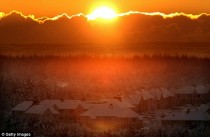
Beautiful cold: The sun sets over the village of Salsburgh in North Lanarkshire yesterday.
David Cameron today ordered the army to help clear away the snow as Britain headed towards its coldest December for 100 years
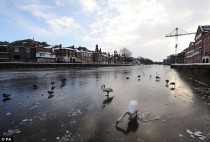
Frozen solid: The River Ouse in the centre of York was iced over for the first time in 50 years yesterday
The Scottish capital has seen the worst snowfall since 1963, leaving some of its most vulnerable residents unable to leave their homes. Up to 30ins of snow has fallen in parts of the city. Under the plans, soldiers will be helping residents from the hardest hit areas of Edinburgh, as well as those who need to get access to medical help.
They will also help to clear special locations such as doctors’ surgeries, care homes and hospitals. The mobilisation of the Army coincides with reports of fuel running out at petrol stations in Scotland and East Anglia. In Scotland a third of the country’s 900 forecourts were closed due to supply chain problems.
After a further 4in of snow fell yesterday the Met Office warned that - despite a brief respite this weekend - temperatures would stay ‘remarkably’ low for another fortnight. If that happens, this month could replace 1981 as the coldest December since records began in 1910. To do so, the average mean temperature for the month will have to be lower than 0.2c. The coldest place in England overnight was Topcliffe in North Yorkshire, which saw a low of -12.8C.
As forecasters warned of more snow, sub-zero temperatures and ice for the Christmas period:
* The Prime Minister urged homeowners to embrace the ‘we’re all in it together’ strategy of the Conservatives Big Society by being good neighbours
* More than 100 motorists were rescued after being trapped as heavy snow fell on the A171 near Whitby, in North Yorkshire
* The AA said it had responded to more than 230,000 incidents in just 14 days.
Some parts of the country have not seen a positive temperature reading for nearly two weeks. Met Office forecaster John Hammond said: “December has got off to a remarkable start. It’s possible it could be the coldest on record. We will have to wait and see but it’s going to stay cold for much of the rest of the month with widespread risk of ice, frost and snow showers.”
He said that the country would enjoy warmer temperatures - as high as 7c (45f) or 8c (46f) - over the weekend before the freeze returns.
“There is scope for more snow showers to come in, particularly next week,” he added. “Widespread ice and frost will return, particularly from the middle of the week onwards.”
Last winter, more than 25,000 people died in England and Wales as a result of the cold temperatures. Most of them were aged over 75. Nigel Stafford, from the British Red Cross, said: “We all need to look out for each other during the severe weather and make sure those less able than ourselves are not forgotten.”
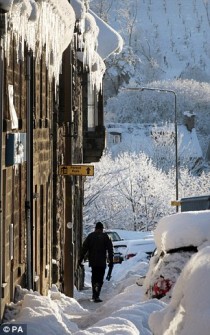
No let-up: A man braves a path in Penicuick, Midlothian
See much more on the amazing UK winter here. Also UK Farmers warned as [50] buildings collapse under snow (Farmers Guardian, UK, December 6, 2010)
Roof at [UK] Tesco superstore collapses under the weight of snow (Daily Mail, UK, December 4, 2010)
Recall thanks to GWPF “The Met Office, using data generated by a 33 million pound supercomputer, claims Britain can stop worrying about a big freeze this year because we could be in for a milder winter than in past years. --Daily Express, 28 October 2010
See also the following warning:
HOUSEHOLD energy bills could double to 2,500 pounds a year in an “unstoppable” rise driven by the 200 billion pound fight against climate change, a market expert warned yesterday. Mark Todd, of energyhelpline.com, said rocketing prices will send costs for hard-pressed families and the elderly into the “stratosphere”. He said consumers will have to pick up the tab for new windfarms, nuclear power plants and the networks needed to support them.
And in France, Paris Shuts Eiffel Tower, Suspends Flights as Snow Halts French Transport. Paris had its heaviest snowstorm since 1987.
